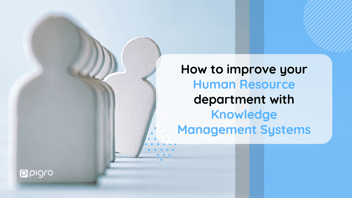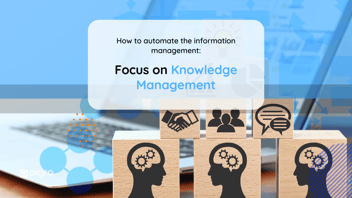HR challenges: a matter of communication
For the growth strategy of a company, it is essential that all departments communicate with each other: this allows everyone to work dynamically and collaboratively, avoiding waste of time and energy.
To do this, it is necessary to create, manage and implement adequate documentation, and to be able to consult it easily at any time.
This is often not the case. The HR department, which is responsible for the management of all personnel, has to deal with a large amount of data and information related to the company's human capital, which can create problems. Let's take a closer look.
Personnel recruitment: difficulties in accessing and managing documents
One of the main tasks of the HR department is the selection and recruitment of personnel, and it consists of three steps:
1. Accessing documents in the candidate research process
To select the right candidate for a given position, it is necessary to carefully present the skills required for the profile sought, through a detailed analysis shared with the managers of each area.
At this stage, it is essential to have access to the company's documentation: a search carried out without having all the elements will affect all the subsequent steps and will lead to the selection of an unsuitable candidate.
Furthermore, only by knowing your resources you can decide whether they are sufficient to search internally or whether the research should be entrusted to external agencies.
2. Speed up the selection of incoming resumes
After the candidate search phase, which aims to receive as many resumes as possible that are relevant to the position to be filled, each resume is reviewed.
One problem encountered in this phase is the management of a large number of documents to be consulted. Often, there are no tools in the company to automatically select resumes with certain skills: this would save employees time by manually eliminating those that do not match the search.
In addition, to speed up the screening phase, resumes must be well organized with shared company policies: without them, staff may not have immediate access to the necessary documentation, which will add time and waste energy.
3. Interview phase for the candidate selection process
Interviews are at the heart of the selection process. After the first step of the recruitment process has been completed and the candidate's professional background matches what is required, individual interviews are held to examine the different aspects of the resume and to provide the potential employee with more information about the contractual aspect, as well as about the company in general.
After the initial interviews, the recruiter will decide whether further interviews are necessary or whether the information available is sufficient to make a decision.
The selection phase, if not well organized and structured, can be very long: candidates who are waiting for the result will continue to interview and send their resumes to other companies, thus decreasing the chances that once selected, they will accept the position.

Training: difficulties in onboarding a new employee into the company
What is Onboarding: meaning and importance
After the staff recruitment phase, it is necessary to integrate the new employee into a work team and to initiate him or her to a task. The training on the materials about the new job position is only the beginning of a more complex path.
Personnel training and development, which include the onboarding phase, are essential parts of the human resources job and can take up to 12 months.
The onboarding represents the integration phase: the new employee must acquire all the knowledge, skills, and behaviours necessary to become an integral part of the company, both at the organizational level and in terms of the corporate culture.
From a human resources management perspective, onboarding is a crucial process when adding a new member to the team. Through this phase, you will be able to transfer (or not) the necessary knowledge to make them fully operational in the team.
What is technically called the onboarding process is nothing more than the process of training and integrating new employees, which consists of providing them with everything they need to "get on board" and keep up with other employees: team members and roles, useful tools, policies, customer information, workplace regulations, and so on.
The challenges of the onboarding process
Onboarding is not just a synonym for "training", but has a broader meaning: it serves to build and strengthen the relationship with the company, colleagues, and managers. The main competitive advantage of onboarding for the company is to improve and exploit the "knowledge" of the employees.
A good onboarding process can also have a positive influence on employee retention (i.e., the ability to avoid employee layoffs and resignations).
A new employee's enthusiasm can be dampened by a very poor learning process in which he or she is inundated with information that is difficult to assimilate, which can lead potentially talented people to choose to leave the company in the future.
Onboarding, therefore, faces several challenges:
-
familiarizing the new employee with the company's tools and systems;
-
teaching the jargon and values of the company to better interact with colleagues;
-
understanding the importance of a training process that is not long, boring, and confusing, but that provides concrete and useful information;
-
paying attention to all the information given during the onboarding: employees often do not pay attention to the training because they come from similar backgrounds or have already used similar tools.
The limits of traditional strategies
Traditional onboarding often consists of long orientation sessions, seminars, slides, and PowerPoint presentations that never seem to end, with the result that new employees become confused by the amount of information conveyed.
Or they are given long manuals and handbooks containing everything they need to know to join the team. These written documents do not guarantee that the employee spends time reading them and, more importantly, they do not allow for a direct exchange of views to seek clarification and clarification.
It also means a greater effort to keep this type of documentation up to date, especially if it is distributed in paper form.
Instead, effective onboarding should be based on short, focused sessions based on the tasks that the recruits will have to perform next.
Personnel management: difficulties in sharing internal documentation
Once the search for the professional is completed and he or she is introduced to the company, the HR department takes care of the other aspects of personnel management.
Assessing employee performance: Key Performance Indicators (KPI)
To understand the performance of each employee, it is necessary to track the results and KPIs of the individual and the team.
This research and analysis phase is simplified by the ability to search for information in the company's documentation, which allows for a quick understanding of the performance level with all available data.
This data should also be shared with employees, who can see the evolution of their performance and take action if it is not in line with expectations together with the human resources managers.
If the data is not available and accessible to staff, the assessment phase will not result in conscious professional development and will only increase employee frustration.
The final goal of strategic human resources management is to motivate employees and foster internal communication throughout the company. This should lead to understanding which obstacles they face in their everyday work routine and how to overcome them.
Increasing employee satisfaction (and productivity)
To increase staff satisfaction, it is necessary to enable them to work productively and efficiently.
Being able to share knowledge with colleagues, both inside and outside of your division, helps you get the most out of your knowledge and grow your business.
Often, not enough attention is paid to establishing a good knowledge-sharing culture, which allows for the exchange of advice and information on procedures and best practices for solving problems, based on individual skills.
Promoting corporate culture
Corporate culture is the values and relationships on which the company is based, a set of elements that the employee perceives in the work environment of which he or she is a part.
One of the tasks of the HR department is to promote the corporate culture by identifying problems and implementing strategies to address them.
One of the main problems in this area is the lack of clear and universally accepted company procedures to structure work and documentation in an organized and standardized way.
When the corporate culture conveys positive values among its employees, such as sharing and collaboration, it is easier for innovative practices to emerge and for the company as a whole to grow.
Read also:
- How to improve your HR department with Knowledge Management System
- Solving HR problems with Knowledge Management
Do you want to know more about Pigro? Contact us!



